|
Nuclear Energy in Belgium (No.17)
May 13rd, 2013
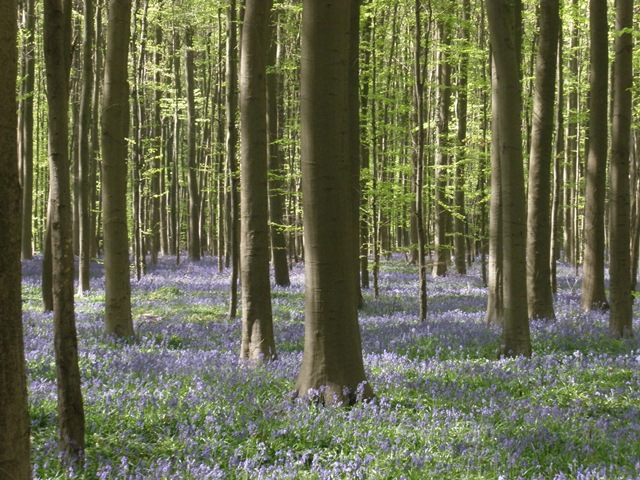 Last weekend, I went for a walk in the “Forest of Halle. When spring is at its height in Brussels, the question “have you been to Halle” is almost like a way of greeting among the Japanese residents. In the beech forest, you will encounter bluebells (wild hyacinths) in full bloom covering the surface like a blue-violet carpet. It is quite a fantastical scene and some people call it even “the number one secret spot in Belgium”. As this spectacle can only be seen for a short period from late April to the beginning of May, Japanese residents tend to greet each other with “did you go to forest of Halle” to remind each other about it. The forest is located at the edge of a small village about 30 km southwest of Brussels. It is not easily accessible without a car, and if you do not check the map in advance, you will get lost. As expected, I did get lost and I asked many times for directions to people living in the vicinity, but their reply was not to the point at all. No wonder that only few Belgians and even few locals know about the forest of Halle. However, it is indeed strange because the forest is so very famous among Japanese that they even visit it with a sightseeing bus. The key to solve this mystery lies in a Japanese company’s commercial aired on Japanese TV. Japanese residents in Belgium heard about this commercial and that’s how this wonderful sight got its reputation. Anyhow, most secret spot in Belgium or not, it may be said that it is a highly recommended course by Japanese people for a walk on a spring weekend. Last weekend, I went for a walk in the “Forest of Halle. When spring is at its height in Brussels, the question “have you been to Halle” is almost like a way of greeting among the Japanese residents. In the beech forest, you will encounter bluebells (wild hyacinths) in full bloom covering the surface like a blue-violet carpet. It is quite a fantastical scene and some people call it even “the number one secret spot in Belgium”. As this spectacle can only be seen for a short period from late April to the beginning of May, Japanese residents tend to greet each other with “did you go to forest of Halle” to remind each other about it. The forest is located at the edge of a small village about 30 km southwest of Brussels. It is not easily accessible without a car, and if you do not check the map in advance, you will get lost. As expected, I did get lost and I asked many times for directions to people living in the vicinity, but their reply was not to the point at all. No wonder that only few Belgians and even few locals know about the forest of Halle. However, it is indeed strange because the forest is so very famous among Japanese that they even visit it with a sightseeing bus. The key to solve this mystery lies in a Japanese company’s commercial aired on Japanese TV. Japanese residents in Belgium heard about this commercial and that’s how this wonderful sight got its reputation. Anyhow, most secret spot in Belgium or not, it may be said that it is a highly recommended course by Japanese people for a walk on a spring weekend.
< Belgium’s Three Regional Governments >
There are three regional governments in Belgium. In Ambassador’s chat No. 5, I talked about my meeting with Mr Kris Peeters, Minister-President of the Flemish government. This time, I had a meeting with Mr Rudy Demotte, Minister-President of the Walloon government, who was very busy with the budget program. I asked for their continued support of nearly 20 Japanese companies mainly active in the manufacturing sector in the Walloon region. He told me that there’s a leading-edge pharmaceutical and aerospace industry in Wallonia and that they are also very active in bio industry and new materials, so he hopes for further cooperation with Japanese companies in these fields. He also mentioned that he visited Japan last June and that he has a keen interest in Japanese culture. Though only 49 years old, he has already had 4 minister posts in the federal government and the previous Minister-President of Wallonia was no one less than current Prime Minister Elio Di Rupo. By this fact alone, I gathered how important this post of Minister-President of the regional government really is. |
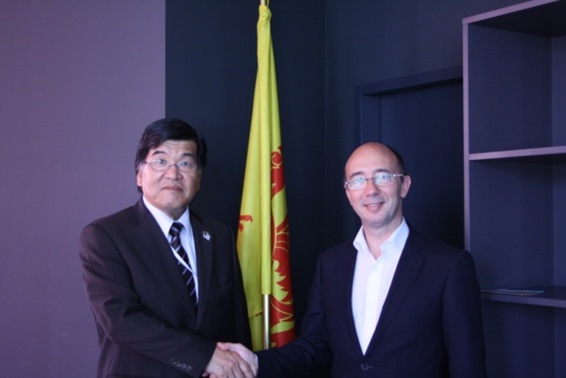 |
| President Demotte |
Furthermore, in connection to the government of the Brussels-Capital region, late February I met with Mr Guy Vanhengel, Deputy Minister-President. Four years ago, Mr Vanhengel served as Deputy Prime Minister of the federal government (and Minister of Budget), after that, he became a Member of Parliament and for the last two years he has been Brussels Minister of Finance, Budget and External Relations. It is a unique career. We talked about the friendship city relationship between Tokyo and Brussels and about strengthening the ties with the Japanese companies operating in Brussels. During our talk, he told me that the performance of Japanese cars is wonderful and that his own car today is still a Japanese car. I was pleased to find a fan of Japanese cars unexpectedly.
< Governor, Mayor and President of the Regional Parliament in Namur >
I visited Namur at the beginning of this month and had the opportunity to meet successively the governor, the mayor and the president of the regional parliament, three leading figures. Governor Mr Denis Mathen emphasized that the Province of Namur is very well located for business activities. Being close to three airports, providing convenient river transport and being close to the highway as well, Namur is a traffic hub. The provincial building was constructed in the first half of the 18th century and at first it was a Catholic facility with a chapel inside, but that room was renovated and is now used once a month for the provincial council. I feel indeed the changing times.
The next person I met was Mayor Mr Maxime Prévot, a very young politician of 35 years old. He showed a strong interest in expanding exchanges with Japan. Since Namur and Ōgaki city (Gifu Prefecture) in Japan have friendly relations, we also discussed international exchanges between local governments. In the city itself, there is the University of Namur and because the research in the field of IT and bio nanotechnology is thriving, the mayor would like to deepen the cooperation with Japanese companies in these fields. Furthermore, when we talked about Japanese tourists, I told him that I encountered that day at noon around 20 Japanese tourists at the restaurant of Namur castle located high above Namur, upon which the mayor asked me how he can get in touch with Japanese travel agencies. I think that in the future we will cooperate with him in various fields.
Lastly, I paid a courtesy call to Mr Patrick Dupriez, President of the Parliament of the Walloon Region and we talked about the role of the regional parliament. There are currently 75 members of parliament and every two weeks a plenary session is held. The members of parliament listen to the Ministers about the current state of the administration and establish ordinances on matters for which they have regional authority. The regional governments were established by the administrative and judicial reforms of 1980. The parliament building seems brand new, but was built in the 12th century as a hospital and underwent a large renovation. When I asked about the big emblem depicting a “fighting rooster” directly behind the president’s seat in the meeting room for the plenary session, he explained that the emblem conveys their “hot combative spirit”. It is quite profound.
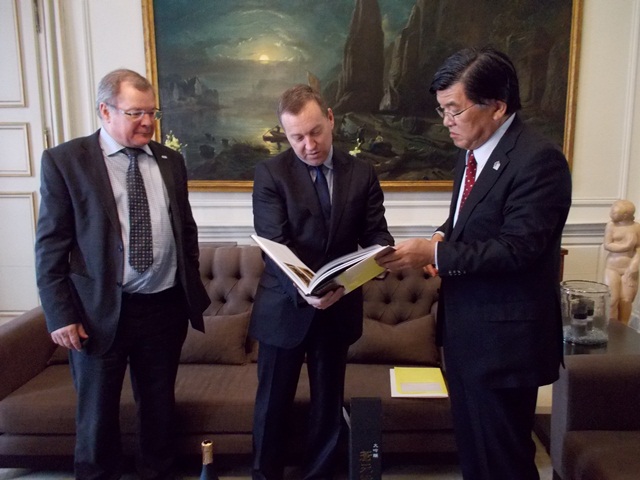 |
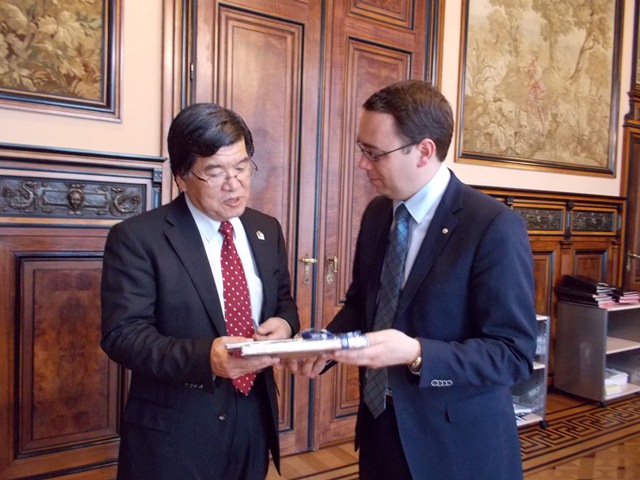 |
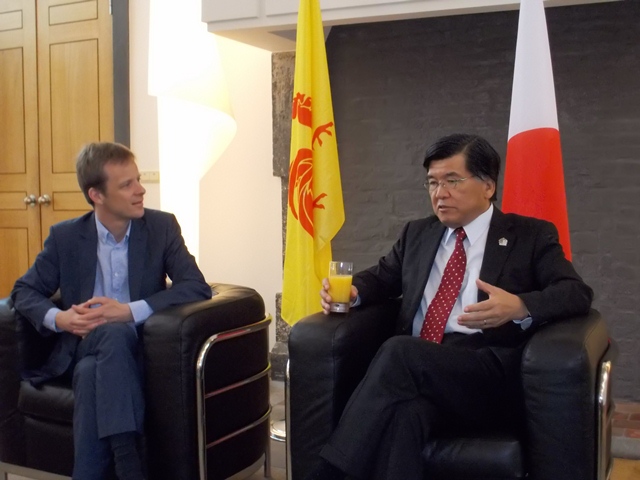 |
| Governor Mathen (center) |
Mayor Prévot |
President Dupriez |
< Belgian Nuclear Research Centre >
There is a small town called Mol located 80 km northeast of Brussels and 10 km from the border of the Netherlands in which the Belgian Nuclear Research Center (SCK. CEN) is situated. I was invited by Prof. Dr. Deconinck, President of the Board of Governors for a visit to this centre. I felt obliged that many executives such as Dr. Van Walle, Director-General, welcomed me. There are 7 nuclear reactors in Belgium and the country depends for more than 50% on nuclear power for its power supply. However, the Belgian government decided already in 2003 on a policy to phase out nuclear plants and the plan is that all nuclear reactors should stop operating by 2025. Considering these circumstances, the Belgian Nuclear Research Centre plans the MYRRHA project and is about to start international joint research on decommissioning and dismantling technologies and on the storage of radioactive waste. Also the Japan Atomic Energy Agency (JAEA) will participate in this project and the details of this cooperation will be discussed later. What was very interesting was the fact that I could take the elevator down to visit the HADES Laboratory, located at a depth of 225 m, which is the site where research of radioactive waste storage is conducted in the Research Centre. There is a horizontally long tunnel of 200 m through a dry clay layer that has remained in the same condition for over 30 million years. They embed radioactive waste in this clay to study the changes over the years. This was really “seeing is believing”. It was a visit full of surprises. |
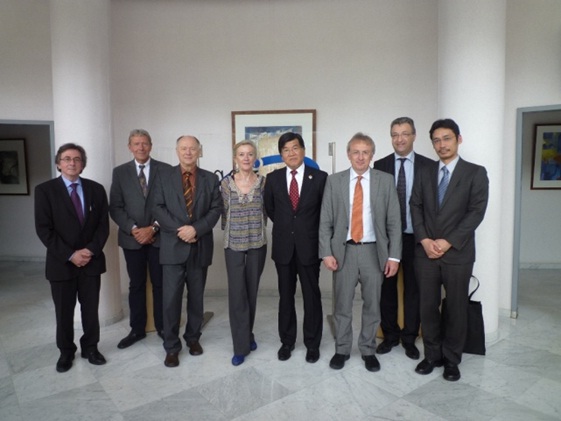 |
| Source:SCK・CEN. Used by permission. |
< A Dog of Flanders, Once More >
About two weeks ago in the weekend, I attended as a guest the closing reception of the Japanese Culture Week in Hoboken, the backdrop of “A Dog of Flanders”. On that day, a workshop Japanese drums and a judo demonstration took place and ikebana floral arrangements and origami were on display in the reception hall. Hoboken, having noticed that the book “A Dog of Flanders” written by a British female author had become very popular in Japan in particular (see Ambassador’s Chat No. 11), holds every year a Japanese Culture Week coinciding with the Golden Week holiday in Japan. I was told that this event is, so to speak, a boost for the development of the town in the sense that it is not only for fans of Japanese culture, but people from the shopping district who are interested in attracting tourists also participate. When I mentioned in my opening speech that I was surprised that the bronze statue of Nello and Patrasche was so small, the people from the town hall commented that they “want to make the statue stand out more”. What was interesting is that they are making various articles using the popularity of “A Dog of Flanders”. They even had local Nello beer, Patrasche beer and Flanders’ chocolates just like the local “senbei” (rice crackers) and “manju” (buns with filling) in Japanese souvenir shops. I was quite impressed with their strong commercial spirit.
< Religious and Cultural Event in Bruges >
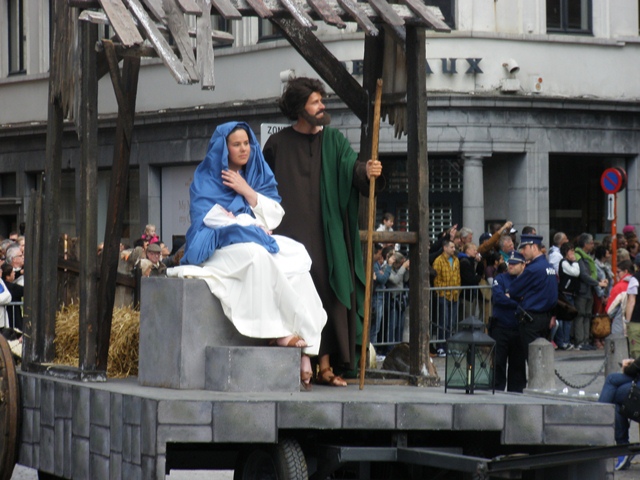 Last week, I received an invitation from the mayor of Bruges, Mr. Renaat Landuyt to view the biggest religious and cultural event of the city, the “Procession of the Holy Blood” (Ambassador’s Chat No. 12). According to the legend (a bit different from what really happened), Thierry d’Alsace, Count of Flanders, who led the Second Crusade in the 12th century, brought Jesus Christ’s blood back from the Holy Land and the relic has been kept ever since in a church in Bruges. On Ascension Thursday the relic of the Holy Blood is carried through the streets of Bruges in the Procession of the Holy Blood. I viewed the spectacle from the front row VIP seats in the Main Square together with the mayor and other distinguished guests. The procession depicts more than 50 biblical and historic scenes from the story of Adam and Eve up to the return with the Holy Blood to Bruges and many citizens dressed in historical costumes parade through the city. In several scenes even a real camel and sheep appeared. The historical tableaux developing in front of me were so impressive that about an hour and a half went by very quickly. The Main Square and surroundings were flooded with spectators. Also for the promotion of tourism this is an important event. Last week, I received an invitation from the mayor of Bruges, Mr. Renaat Landuyt to view the biggest religious and cultural event of the city, the “Procession of the Holy Blood” (Ambassador’s Chat No. 12). According to the legend (a bit different from what really happened), Thierry d’Alsace, Count of Flanders, who led the Second Crusade in the 12th century, brought Jesus Christ’s blood back from the Holy Land and the relic has been kept ever since in a church in Bruges. On Ascension Thursday the relic of the Holy Blood is carried through the streets of Bruges in the Procession of the Holy Blood. I viewed the spectacle from the front row VIP seats in the Main Square together with the mayor and other distinguished guests. The procession depicts more than 50 biblical and historic scenes from the story of Adam and Eve up to the return with the Holy Blood to Bruges and many citizens dressed in historical costumes parade through the city. In several scenes even a real camel and sheep appeared. The historical tableaux developing in front of me were so impressive that about an hour and a half went by very quickly. The Main Square and surroundings were flooded with spectators. Also for the promotion of tourism this is an important event.
|

